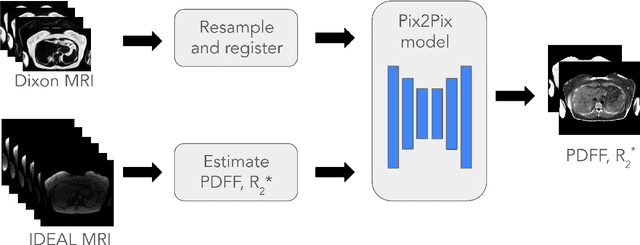Suma Anand
Synthesizing Proton-Density Fat Fraction and $R_2^*$ from 2-point Dixon MRI with Generative Machine Learning
Oct 15, 2024



Abstract:Magnetic Resonance Imaging (MRI) is the gold standard for measuring fat and iron content non-invasively in the body via measures known as Proton Density Fat Fraction (PDFF) and $R_2^*$, respectively. However, conventional PDFF and $R_2^*$ quantification methods operate on MR images voxel-wise and require at least three measurements to estimate three quantities: water, fat, and $R_2^*$. Alternatively, the two-point Dixon MRI protocol is widely used and fast because it acquires only two measurements; however, these cannot be used to estimate three quantities voxel-wise. Leveraging the fact that neighboring voxels have similar values, we propose using a generative machine learning approach to learn PDFF and $R_2^*$ from Dixon MRI. We use paired Dixon-IDEAL data from UK Biobank in the liver and a Pix2Pix conditional GAN to demonstrate the first large-scale $R_2^*$ imputation from two-point Dixon MRIs. Using our proposed approach, we synthesize PDFF and $R_2^*$ maps that show significantly greater correlation with ground-truth than conventional voxel-wise baselines.
Beat Pilot Tone: Versatile, Contact-Free Motion Sensing in MRI with Radio Frequency Intermodulation
Jun 17, 2023Abstract:Motion in Magnetic Resonance Imaging (MRI) scans results in image corruption and remains a barrier to clinical imaging. Motion correction algorithms require accurate sensing, but existing sensors are limited in sensitivity, comfort, or general usability. We propose Beat Pilot Tone (BPT), a radio frequency (RF) motion sensing system that is sensitive, comfortable, versatile, and scalable. BPT operates by a novel mechanism: two or more transmitted RF tones form standing wave patterns that are modulated by motion and sensed by the same receiver coil arrays used for MR imaging. By serendipity, the tones are mixed through nonlinear intermodulation in the receiver chain and digitized simultaneously with the MRI data. We demonstrate BPT's mechanism in simulations and experiments. Furthermore, we show in healthy volunteers that BPT can sense head, bulk, respiratory, and cardiac motion, including small vibrations such as displacement ballistocardiograms. BPT can distinguish between different motion types, achieve greater sensitivity than other methods, and operate as a multiple-input multiple-output (MIMO) system. Thus, BPT can enable motion-robust MRI scans at high spatiotemporal resolution in many applications.
 Add to Chrome
Add to Chrome Add to Firefox
Add to Firefox Add to Edge
Add to Edge